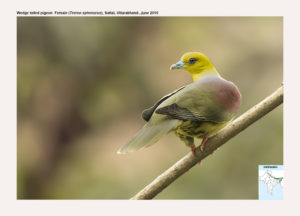Wedge-tailed Green Pigeon

Wedge-tailed Green Pigeon Treron sphenurus
Etymology:
- Treron : Greek word for Pigeon
- Sphenurus: Greek word sphen- wedge; ouros –tailed
Vernacular Names: Hindi: KokolaHarial, Kokila, H.P.: Kainal, Ass: Haitha, Borhaitha/haithak, Cachar: Daorepgadeba,Lepcha: Kaku, Kuhu-pho
Distribution in India : Resident of Himalayas and North East India.
Description: Size of 29-33 cm. The Head, neck and underparts are bright yellowish-green, becoming coppery gold on crown and breast; breast feathers are salmon-pink, being golden only at tips; flanks and vent streaked pale yellowish and dark green; long under tail-coverts pale yellowish chestnut; hind neck bright green becoming vinous grey on upper mantle; inner wing-coverts and varying amount of scapulars and mantle dark purplish chestnut; rest of upperparts dark green or grey-green; outer secondaries and primaries blackish, with narrow yellow fringes to greater-coverts, secondaries and primaries; tail bluntly wedge-shaped; central tail feathers concolorous with back; outer ones grey with blackish sub-terminal band; under tail light grey; orbital skin light blue; bill light blue at base, whitish blue or greyish at tip; feet bright red or deep pink. Female has head and breast entirely pale yellowish green, and upperparts dark green, lacking maroon and golden colours of male; under tail-coverts pale yellow with dark green central stripes.The juvenile much like adult female but duller; young male acquires some maroon feathers before fully grown.
Habitat: It is found in forests and second growth; primarily in broad-leafed forests of oak, elm, laurel and rhododendron; found in plains, foothills and mountains.
Food Habits: It is frugivorous, taking a variety of fruits and berries, including figs and mulberries. Feeds acrobatically in canopy, often hanging upside-down to reach fruit on small twigs; visits the ground to pick up earth at salt-licks
Breeding Habits: They breed in April-Aug. The nest is a frail platform of twigs. The Nest is placed close to trunk on a large branch; nest often placed near an active Drongo (Dicrurus) nest, presumably to benefit from the aggressive defense provided by these species. They lay a clutch of 1–2 white eggs. Incubation is done by both sexes, for 18–19 days and fledging period is 12 days.